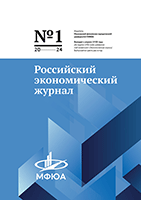Архив
Российский экономический журнал 6 / 2022
Россия — МЕРКОСУР: императив и потенциал двусторонней торговли
Чиркин С.А.
Мировая экономика
Научная статья
УДК 339.56, 339.9
https://doi.org/10.33983/0130-9757-2022-6-78-92
РОССИЯ — МЕРКОСУР: ИМПЕРАТИВ И ПОТЕНЦИАЛ ДВУСТОРОННЕЙ ТОРГОВЛИ
Сергей Алексеевич Чиркин — соискатель ученой степени кандидата экономических наук кафедры мировой экономики, советник при ректорате РЭУ им. Г.В. Плеханова, Москва, Россия, Chirkin.SA@rea.ru, https://orcid. org/0000-0001-6216-2548
Аннотация. В статье исследуются состояние и перспективы развития внешнеторговых связей России с южноамериканским интеграционным объединением МЕРКОСУР. В свете антироссийских санкций Запада характеризуется позиция государств-членов блока по вопросу развития экономических отношений с нашей страной. Дается оценка макроэкономической значимости МЕРКОСУР и основных направлений его торговой политики. Приводятся количественные показатели по объемам и динамике двустороннего внешнеторгового оборота, структуре экспорта и импорта товаров. С учетом наличия благоприятных предпосылок к расширению торгово-экономического сотрудничества с использованием методики Центра международной торговли Конференции ООН по торговле и развитию рассчитывается потенциал увеличения экспорта российских товаров в страны МЕРКОСУР. В рамках анализа возможностей диверсификации номенклатуры поставок отечественной продукции на основании методологии Хаусманна-Клингера выделяются наиболее перспективные российские товары для выхода на рынок МЕРКОСУР. В заключении высказываются соображения, направленные на активизацию двусторонних торгово-экономических связей на фоне западных санкций.
Ключевые слова: Россия, МЕРКОСУР, внешняя торговля, экспортный потенциал, таможенный союз, единый внешний тариф, зона свободной торговли, диверсификация экспорта, концепция Хаусманна-Клингера
Для цитирования: Чиркин С.А. Россия — МЕРКОСУР: императив и потенциал двусторонней торговли // Российский экономический журнал. 2022. № 6. С. 78–92. https://doi.org/10.33983/0130-9757- 2022-6-78-92.
World economy
Original article
RUSSIA — MERCOSUR: IMPERATIVE AND POTENTIAL OF BILATERAL TRADE
Sergey A. Chirkin — Postgraduate Student of the Department of World Economy, Counsellor to the Rector’s Office, Plekhanov Russian University of Economics, Moscow, Russia, Chirkin.SA@rea.ru, https://orcid.org/0000-0001-6216-2548
Abstract. The article examines the state and prospects of development of Russia’s foreign trade relations with MERCOSUR. In the light of the West’s anti-Russian sanctions, the position of the bloc’s member states on the development of economic relations with our country is characterized. The assessment of the macroeconomic significance of MERCOSUR and the main directions of its trade policy is given. Quantitative indicators on the volumes and dynamics of bilateral foreign trade turnover, the structure of exports and imports of goods are given. Taking into account favorable prerequisites for expanding trade and economic cooperation, using the methodology of the International Trade Center of the UN Conference on Trade and Development, the potential for increasing exports of Russian goods to MERCOSUR countries is calculated. As part of the analysis of the possibilities of diversifying the range of supplies of Russian products based on the Hausmann-Klinger methodology, the most promising Russian goods for entering the MERCOSUR market are identified. In conclusion, there are considerations aimed at intensifying bilateral trade and economic ties against the background of Western sanctions.
Keywords: Russia, MERCOSUR, foreign trade, export potential, customs union, single external tariff, free trade zone, export diversification, Hausmann-Klinger concept
For citation: Chirkin S.A. Russia — MERCOSUR: Imperative and potential of bilateral trade. Russian Economic Journal. 2022;(6):78–92. (In Russ.). https://doi.org/10.33983/0130-9757-2022-6-78-92.
Список источников
- Яковлев П.П. Стратегическое партнерство России со странами Латинской Америки: тенденции и контртенденции // Перспективы. Электронный журнал. 2016. № 1. C. 40–51.
- Холодков Н.Н. Российско-латиноамериканские экономические отношения в условиях западных санкций // Латинская Америка. 2018. № 1. C. 5–18.
- Школяр Н.А. Внешняя торговля России с ЛКА: состояние и перспективы // Латинская Америка. 2020. № 5. C. 6–17.
- Чиркин С.А. Россия и МЕРКОСУР — естественные торгово-экономические партнеры в условиях нового мирохозяйственного порядка // Инновации и инвестиции. 2022. № 5. С. 30–35.
- Чиркин С.А. Россия — Бразилия: утверждение стратегического партнерства // Российский экономический журнал. 2021. № 4. С. 94–110. https://doi.org/10.33983/0130-9757-2021-4-94-110.
- Lomeu Campos G. From Success to Failure: Under what conditions did Mercosur integrate? Journal of Economic Integration. 2016;31(4):862–864.
- Чиркин С.А. Прямые иностранные инвестиции в регионе Латинской Америки и Карибского бассейна — эволюция потоков // Международная торговля и торговая политика. 2021. Т. 7, № 3. С. 50–63. https://doi.org/10.21686/2410-7395-2021-3-50-63.
- Decreux Y., Spies J. Export Potential Assessments // International Trade Centre. URL: https://umbraco.
intracen.org/media/1089/epa-methodology_141216.pdf (дата обращения: 25.06.2022).
- Hausmann R., Klinger B. Structural transformation and patterns of comparative advantage in the product space. СID Working Paper. 2006. № 128. URL: https://www.hks.harvard.edu/sites/default/ files/centers/cid/files/publications/faculty-working-papers/128.pdf (дата обращения: 25.06.2022).
References
- Yakovlev P.P. Russia’s Strategic Partnership with Latin American countries: Trends and counter-trends. Perspektivy. Elektronnyy zhurnal. 2016;(1):40–51. (In Russ.).
- Kholodkov N.N. Russian-Latin American economic relations under Western sanctions. Latinskaya Amerika. 2018;(1):5–18. (In Russ.).
- Shkolyar N.A. Russia’s foreign trade with Latin America: state and prospects. Latinskaya Amerika. 2020;(5):6–17. (In Russ.).
- Chirkin S.A. Russia and MERCOSUR are natural trade and economic partners in the new world economic order. Innovations and Investments. 2022;(5):30–35. (In Russ.).
- Chirkin S.A. Russia — Brazil: approval of strategic partnership. Russian Economic Journal. 2021;(4):94–110. (In Russ.). https://doi.org/10.33983/0130-9757-2021-4-94-110.
- Lomeu Campos G. From Success to Failure: Under what conditions did Mercosur integrate? Journal of economic Integration. 2016;31(4):862–864.
- Chirkin S.A. Foreign direct investment in Latin America and the Caribbean — the evolution of flows. International Trade and Trade Policy. 2021;7(3):50–63. (In Russ.). https://doi. org/10.21686/2410-7395-2021-3-50-63.
- Decreux Y., Spies J. Export Potential Assessments. International Trade Centre. URL: https://umbraco.exportpotential.intracen.org/media/1089/epa-methodology_141216.pdf (date of access: 25.06.2022).
- Hausmann R., Klinger B. Structural transformation and patterns of comparative advantage in the product space. СID Working Paper. 2006;(128). URL: https://www.hks.harvard.edu/sites/ default/files/centers/cid/files/publications/faculty-working-papers/128.pdf (date of access: 25.06.2022).
Статья поступила в редакцию 29.06.2022; одобрена после рецензирования 18.08.2022; принята к публикации 21.10.2022.
The article was submitted 29.06.2022; approved after reviewing 18.08.2022; accepted for publication 21.10.2022.

